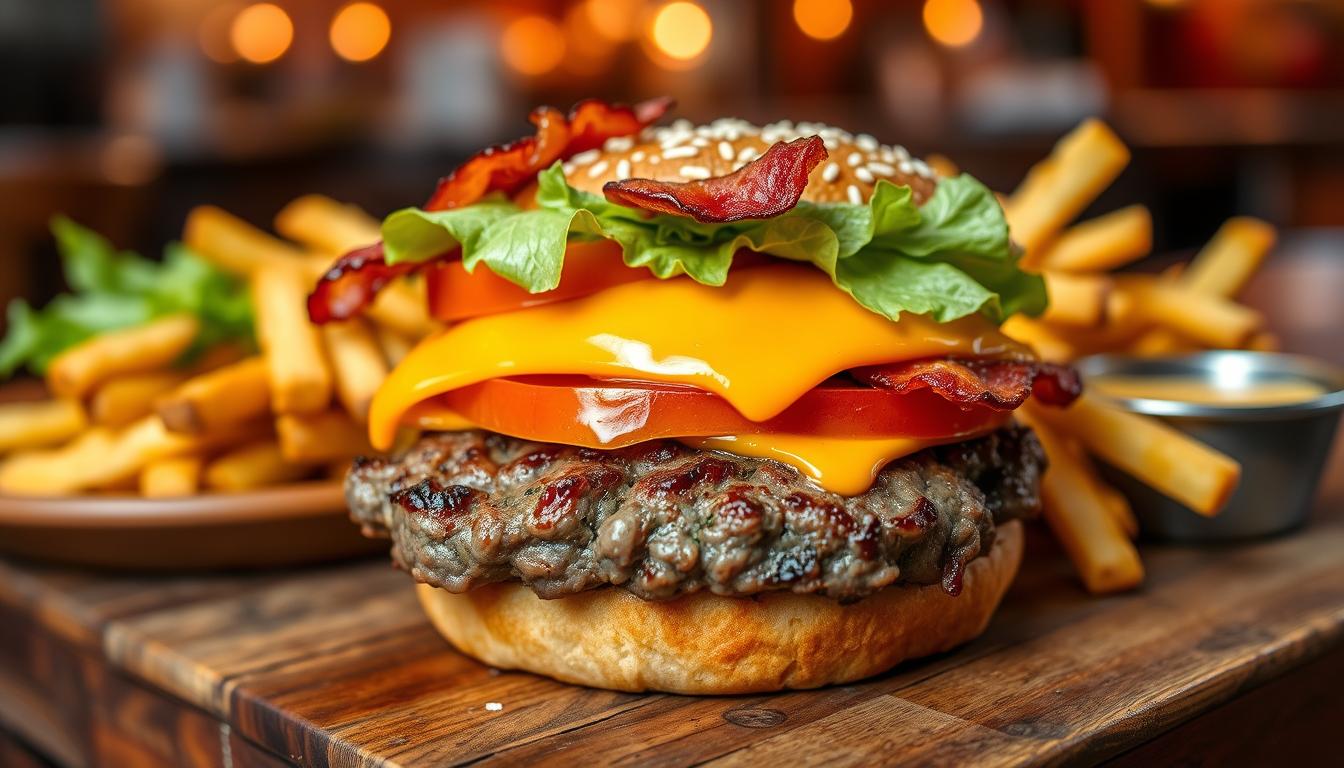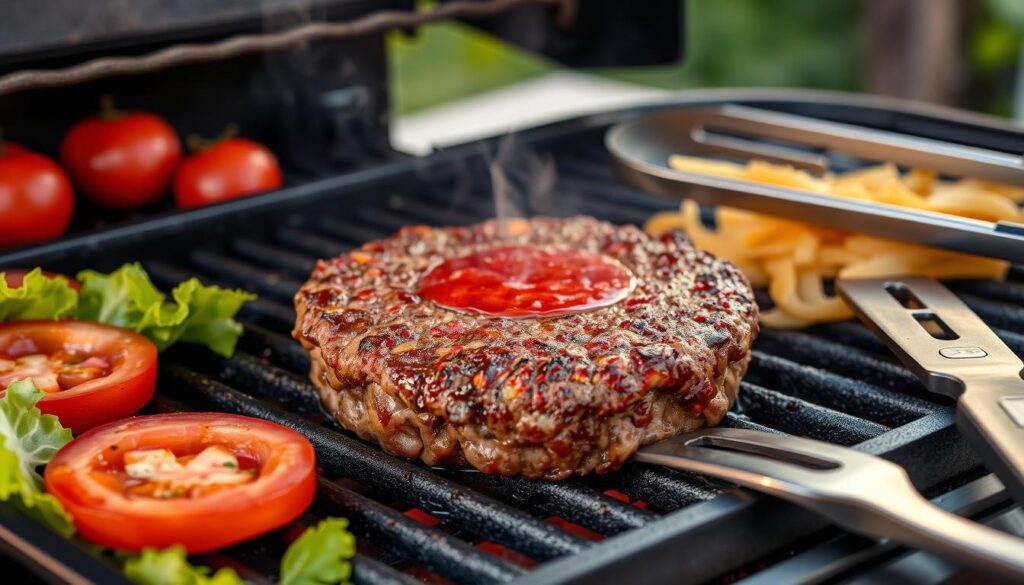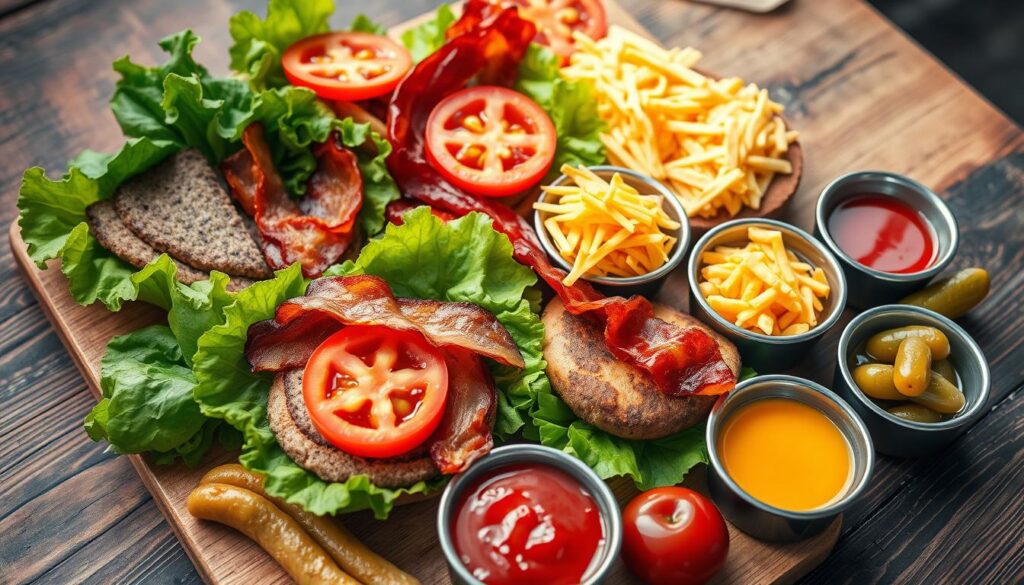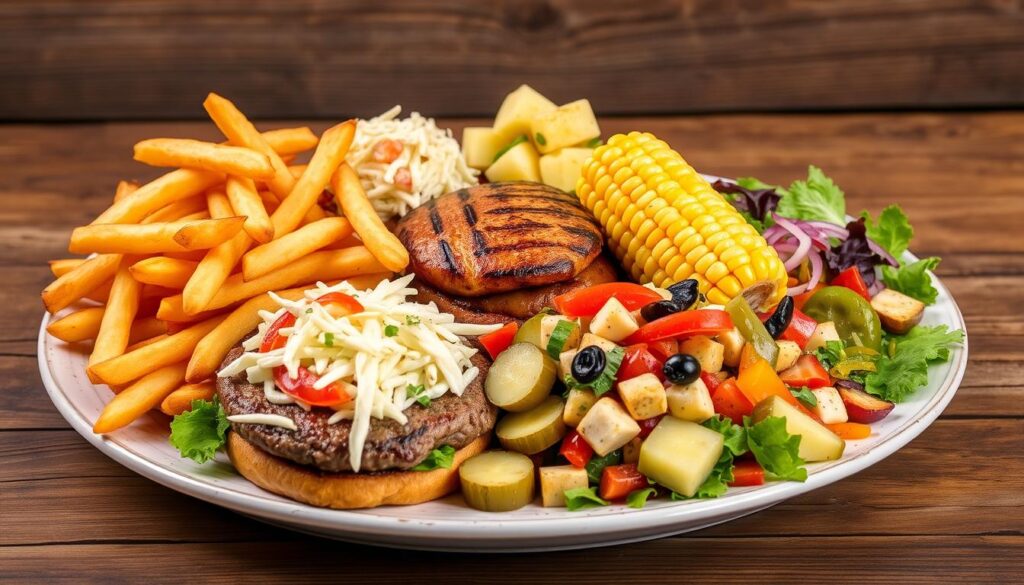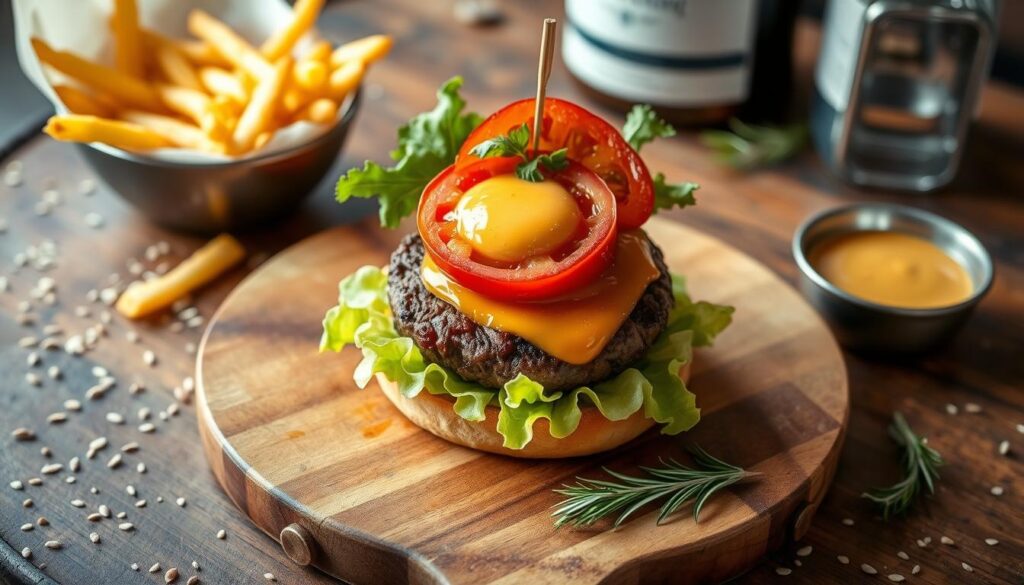Summer evenings are perfect for grilling a mouthwatering medium rare burger. The first time I made a gourmet burger, I knew I’d found a secret. Watching the juices sizzle was magical.
A medium rare burger is all about balance. Grilling experts like Steven Raichlen suggest an 80/20 beef blend. This makes your burger both tasty and tender. It’s more than just dinner; it’s a celebration of good food that brings people together.
Creating a great burger starts with quality ingredients and technique. Whether you grill on weekends or cook in your kitchen, this guide will help. You’ll learn to make a medium rare burger that everyone will love. Get ready to make your dinner game stronger with a burger that’s truly special.
What is a Medium Rare Burger?
Finding the perfect beef patty is an art. It mixes cooking skills with flavor knowledge. A medium rare burger is the top choice for those who love great taste and texture.
Understanding the Ideal Cook Temperature: medium rare burger
The temperature of a burger is key to a great meal. For a medium rare burger, aim for 130°F to 135°F inside. This temperature gives you:
- Warm red center
- Perfectly melted internal fat
- Tender and juicy meat texture
“Temperature is the secret weapon in creating a truly remarkable burger experience.”
The Science Behind Juiciness and Flavor
A juicy burger is not just luck. It’s about knowing meat science. Cooking a beef patty to medium rare breaks down proteins but keeps moisture. This makes the fat melt evenly, giving a rich flavor that makes a burger stand out.
| Burger Doneness | Temperature Range | Meat Appearance |
|---|---|---|
| Rare | 120-125°F | Cool red center |
| Medium Rare | 130-135°F | Warm red center |
| Medium | 140-145°F | Warm pink center |
Pro tip: Always use a meat thermometer to ensure precise cooking and food safety when preparing your burger.
Choosing the Right Ground Beef
Choosing the right ground beef is key to making a great burger. The right cut and fat content can turn a dry patty into a juicy, flavorful burger. This makes a big difference in taste.
Ground beef comes in different cuts, but two stand out for burgers: ground chuck and ground sirloin. Each has its own special qualities that can enhance your burger.
Understanding Meat Cuts for Perfect Burgers
- Ground Chuck: The top choice for burgers, with 80/20 fat content (80% lean, 20% fat)
- Ground Sirloin: A leaner option, with about 90/10 fat ratio
- Adding brisket and short ribs can boost beef flavor
The Critical Role of Fat Content
Fat content is what makes a burger juicy and flavorful. Ground chuck with an 80/20 ratio is ideal. It offers great taste and juiciness. But, a 90/10 ratio can make burgers dry and less tasty.
“Fat is flavor” – Culinary experts agree that a higher fat content ensures a more delicious burger experience.
Stores sell ground beef in various blends, from 70/30 to 93/7. For medium-rare burgers, 80/20 is best. This fat content keeps the burger moist and adds to its rich taste.
Customizing Your Burger Blend
Feel free to mix and match your ground beef. Some chefs mix ground chuck and sirloin for the perfect balance. The goal is to find a mix that you like and that fits your cooking style.
Pro tip: If unsure, go for a blend with a bit more fat. This helps avoid dry burgers and ensures a tasty meal every time.
Preparing Your Burger Patties
Making the perfect burger patties is an art. It needs attention to detail and some key techniques. Your burger’s success begins with how you shape and season the meat. Whether you grill in your backyard or cook at home, mastering burger patties will make your meal better.
Mastering the Art of Shaping Burgers
Here are the essential guidelines for shaping burger patties:
- Use ground chuck with an 80/20 meat-to-fat ratio for optimal juiciness
- Keep meat cold while shaping to prevent fat from melting
- Create patties 3-4 inches in diameter and ¾ to 1 inch thick
- Make a shallow depression in the center to prevent puffing during cooking
Seasoning Your Burger Patties for Maximum Flavor
Seasoning burger patties is key for rich, delicious taste. Professional chefs say to keep seasoning simple yet impactful. Salt and pepper are your primary flavor enhancers. Sprinkle these seasonings generously on the outside of your patties just before cooking.
“The secret to a great burger is quality meat and simple seasoning” – Professional Grill Master
Pro tip for seasoning burger patties: Avoid mixing seasonings directly into the meat. This can make the meat dense and tough. Instead, season the exterior right before cooking to keep the meat tender.
- Use kosher salt for better flavor distribution
- Freshly ground black pepper adds depth
- Optional: Light sprinkle of steak seasoning for extra complexity
Cooking Methods for Medium Rare Burgers
Learning to cook medium rare burgers is all about the right techniques. These methods keep the meat juicy and full of flavor. Whether you like grilling or pan-searing, the choice affects your burger’s taste.
There are two main ways to cook a perfect burger: grilling and pan-searing. Each method has its own benefits for getting that medium rare just right.
Grilling: Tips for the Perfect Cook
Grilling is a favorite among burger lovers. Here are some key tips for a great grilled burger:
- Preheat your grill to 450-500°F for optimal heat
- Clean and oil the grates to prevent sticking
- Cook for approximately 3 minutes per side for medium rare
- Aim for an internal temperature between 130-135°F
“The secret to a great grilled burger is high heat and minimal handling.”
Pan-Seared Burgers: An Alternative Method
If you don’t have a grill, pan-searing is a great option. A cast-iron skillet is best for a perfect sear:
- Use a cast-iron skillet or flat-top grill
- Heat the skillet over medium-high heat
- Add a small amount of butter for enhanced flavor
- Cook 2-3 minutes per side for medium rare
Pro tip: Don’t press down on the patties while cooking. This pushes out juices that make your burger moist and tasty.
Remember, the key to perfect cooking methods is maintaining the burger’s natural moisture and achieving the right internal temperature.
Checking for Doneness
To get the perfect burger, you need precision and the right tools. A meat thermometer is your best friend for a delicious burger. It helps you get the ideal internal temperature.
Mastering the Meat Thermometer
Using a meat thermometer is the most accurate way to check burger doneness. Stick the thermometer through the side of the patty for the best reading. Different temperatures give different flavors:
- Rare: 120°F to 125°F
- Medium Rare: 130°F to 135°F
- Medium: 140°F to 145°F
- Medium Well: 155°F
- Well Done: 160°F or higher
Visual Cues for Perfect Burger Cooking Temperature
While a meat thermometer is key, experienced chefs also look for visual signs. A medium rare burger should have:
- A nice golden-brown crust
- A warm pink center
- Slight springiness when pressed
“The thermometer doesn’t lie – it’s the most reliable way to check burger doneness.” – Professional Chef
| Doneness Level | Internal Temperature | Visual Appearance |
|---|---|---|
| Rare | 120-125°F | Cool red center |
| Medium Rare | 130-135°F | Warm pink center |
| Medium | 140-145°F | Slight pink center |
| Well Done | 160°F+ | No pink, fully brown |
Pro tip: Always clean your meat thermometer between uses to prevent cross-contamination and ensure accurate readings.
Essential Burger Toppings
Making the perfect burger is more than just cooking the patty. The right toppings can turn a simple meal into a feast for the senses. Whether you choose classic or unique toppings, your burger can be a masterpiece of flavors and textures.
Classic Choices to Elevate Your Burger
Some toppings are timeless in burgers. Crisp iceberg lettuce adds a refreshing crunch. Ripe summer tomatoes burst with juicy flavor. Sliced onions add a sharp, tangy taste that pairs well with the meat.
- Cheese for burgers: American, Cheddar Jack, and Pepper Jack
- Fresh vegetables: Lettuce, tomatoes, onions
- Classic condiments: Ketchup, mustard, mayonnaise
Unique Toppings to Surprise Your Taste Buds
For those who like to try new things, here are some unique toppings. Candied jalapeños (cowboy candy) mix sweet and spicy. Pickled red onions add a tangy crunch that makes the burger better.
“A great burger is all about bold flavors and unexpected combinations.” – Culinary Expert
- Creamy options: Sliced avocado or homemade guacamole
- Spicy additions: Fresh or pickled jalapeños
- Unique condiments: Ghost Pepper Ranch, Spicy Mayo
Don’t be shy to try new things with your burger toppings. Try whiskey bacon jam or mango chutney. Mix and match to find your ultimate burger.
Selecting the Right Bun
Choosing the perfect burger bun is crucial. The right bun is the foundation of a great burger. It balances texture and flavor, making your meal better.
Characteristics of the Perfect Burger Bun
A great burger bun should have a few key traits. Your ideal bun should be:
- Sturdy enough to hold burger ingredients
- Soft enough for easy biting
- Capable of absorbing burger juices without becoming soggy
- Complementary to your burger’s flavor profile
Popular Bun Options in the U.S.
There are many great burger bun options. The brioche bun is a top pick. It has a rich, buttery taste and is very sturdy.
| Bun Type | Characteristics | Best Used With |
|---|---|---|
| Brioche Bun | Rich, buttery, sturdy | Gourmet burgers |
| Potato Roll | Soft, slightly sweet | Classic beef burgers |
| Sesame Seed Bun | Traditional, slightly nutty | Classic American-style burgers |
Pro tip: Always toast your burger bun lightly. Toasting adds a nice crunch and prevents sogginess.
“The bun is not just a holder, it’s a key ingredient in the burger experience.” – Burger Enthusiast
Side Dishes to Pair with Your Burger
Make your burger meal special with the right side dishes. They can turn a simple dinner into a memorable experience.
Classic Sides That Never Disappoint
Some burger sides are timeless favorites. French fries are the top choice, offering a crispy contrast to the juicy burger. Potato salad is a creamy option that adds richness to your meal.
- Classic French fries
- Crispy onion rings
- Traditional potato salad
- Coleslaw
Creative Options to Surprise Your Guests
Try new burger sides to impress your guests. Here are some exciting options:
- Air-fried sweet potato fries
- Grilled vegetable skewers
- Southwest corn salad
- Herbed steak fries
*Pro tip: Mix and match sides to create a unique dining experience that keeps everyone excited about the meal!*
Each side dish has its own taste and health benefits. For example, a fresh corn salad is quick to make and serves four. Crispy baked onion rings are a fast option that feeds eight.
Whether you love classic sides like french fries or want to try a zesty potato salad, there’s something for everyone. The goal is to find flavors and textures that match your perfectly cooked burger.
Beverage Pairings for Medium Rare Burgers
Finding the right drink for your medium rare burger can make a big difference. It can turn a simple meal into a special experience. The right drink brings out the best in your burger and makes the meal unforgettable.
Best Alcoholic Choices for Beer and Burgers
Beer lovers have many great options to pair with burgers. Craft beer fans will enjoy these pairings:
- India Pale Ale (IPA) for bold burger flavors
- Lager for a crisp, refreshing complement
- Stout for rich, hearty burger variations
Wine Pairing Recommendations
Wine enthusiasts can find the perfect match for their burgers with these choices:
- Zinfandel for robust meat flavors
- Merlot with classic cheeseburgers
- Cabernet Sauvignon for gourmet burger styles
Delightful Non-Alcoholic Soft Drinks
Soft drinks are great for those who don’t drink alcohol. They pair well with burgers:
- Classic cola with traditional burgers
- Root beer for a nostalgic touch
- Flavored sparkling water for a lighter option
“The right beverage can turn a good burger into an unforgettable meal.”
Try different drinks to find your favorite burger match. Whether it’s beer, wine, or soft drinks, there’s a perfect pairing for your medium rare burger.
Tips for Serving Your Medium Rare Burger
Serving a perfect medium rare burger is an art. It’s not just about cooking. Your burger presentation can turn a simple meal into a masterpiece.
Burger plating needs attention to detail. The right approach makes your burger look as good as it tastes.
Plate Presentation Ideas
- Choose a clean, warm plate to showcase your burger
- Position the burger slightly off-center for visual interest
- Use small ramekins for additional sauces or pickles
- Insert a long toothpick to maintain burger structure
- Arrange side dishes strategically around the burger
Temperature Considerations Before Serving
Serving temperature is key for flavor and texture. Serve immediately after resting to keep it warm and juicy.
| Burger Doneness | Internal Temperature | Serving Recommendation |
|---|---|---|
| Medium Rare | 125-130°F | Serve immediately after 3-minute rest |
| Medium | 140-145°F | Serve within 2-3 minutes of cooking |
| Medium Well | 150-155°F | Can be tented with foil briefly |
“A perfectly served burger is a symphony of temperature, presentation, and flavor.”
When holding burgers before serving, use a loose foil tent. Be cautious, as this can soften the bun. The goal is to keep the burger warm without losing its crisp exterior and tender interior.
Storing Leftover Burgers
After enjoying a delicious medium rare burger, you might find yourself with some tasty leftovers. Storing burgers correctly ensures you can enjoy them later without compromising flavor or safety.
Proper storage of leftover burgers requires careful attention to temperature and packaging. The U.S. Department of Agriculture recommends cooling cooked burgers within two hours of preparation to prevent bacterial growth.
Best Practices for Refrigeration
- Cool burgers to room temperature quickly
- Wrap each burger individually in aluminum foil
- Place in an airtight container
- Refrigerate within two hours of cooking
- Store for no more than 3-4 days
Tips for Reheating Without Losing Flavor
Reheating leftover burgers can be tricky. The key is to maintain moisture and prevent drying out the meat. Avoid using a microwave, which can quickly remove essential juices.
- Use a skillet over medium-low heat
- Add a splash of water to create steam
- Cover the pan to retain moisture
- Alternatively, reheat in an oven at 350°F for about 10 minutes
- Ensure internal temperature reaches 165°F for food safety
“The secret to great reheated burgers is keeping them juicy and flavorful.” – Professional Chef
By following these guidelines for storing burgers and reheating leftover burgers, you can enjoy a delicious meal that tastes almost as good as when it was first cooked.
Burger Cooking Safety Tips
Mastering food safety is key when making burgers at home. Your cooking method affects the health and taste of your meal. Ground beef can carry harmful bacteria like E. coli, so handling it safely is vital.
Temperature control is your best defense in burger safety. Different meats need different internal temperatures. Beef and bison should be at 155-160°F, while chicken and turkey need 165°F. Use a meat thermometer to check these temperatures, as different parts of the burger can be up to 20 degrees different.
Guidelines for Safe Food Handling
Always start with clean hands and surfaces when making burgers. Use separate cutting boards for raw meat to avoid cross-contamination. This can spread bacteria at a 10 percent rate. Refrigerate ground meat until you cook it and avoid overhandling to keep meat quality high and prevent bacterial spread.
Avoiding Common Cooking Mistakes
Professional chefs say to cook burgers on high heat for 4-5 minutes per side. This keeps juices in and enhances flavor through the Maillard reaction. Remember, burgers keep cooking after they’re removed from heat, so plan your cooking time well. By following these tips, you’ll make tasty burgers and keep your family safe.
FAQ
What is the ideal internal temperature for a medium rare burger?
A medium rare burger should have an internal temperature of 130-135°F. This makes the center pink with a warm red middle. It also makes the burger juicy and flavorful.
What type of ground beef is best for making a juicy burger?
The best ground beef is an 80/20 mix (80% lean beef, 20% fat), usually ground chuck. This mix gives the best flavor and juiciness. Some people mix ground chuck and sirloin for a leaner ratio.
How do I prevent my burger patties from becoming tough?
To avoid tough burgers, don’t overwork the meat. Keep it cold and work quickly. Form patties about 1-inch thick and season just before cooking.
How long should I cook a medium rare burger?
Cook a 1-inch thick patty for 4-5 minutes per side on a 450-500°F grill. For pan-searing, cook for 2-3 minutes per side in a cast-iron skillet. Always check with a meat thermometer to ensure it’s 130-135°F.
Is it safe to eat a medium rare burger?
While the USDA says to cook ground beef to 160°F, many serve medium rare. Use fresh, high-quality beef and follow proper cooking and handling techniques.
What are some recommended toppings for a medium rare burger?
Classic toppings are sliced tomato, lettuce, and onions. Try Swiss, cheddar, or Havarti cheese. For something different, add cowboy candy, pickled red onions, sliced avocado, or homemade sauces.
What type of bun works best for a burger?
Brioche buns are great because of their rich flavor and sturdy texture. Sesame seed buns, potato rolls, or pretzel buns are also good. Butter and toast the bun lightly before serving to add flavor and prevent sogginess.
How do I store leftover burgers?
Cool burgers to room temperature within two hours. Then, wrap them in foil or plastic wrap. Store in an airtight container in the fridge for 3-4 days. Reheat in a skillet on medium-low or an oven at 350°F, ensuring it’s 165°F.
What drinks pair well with a medium rare burger?
Cold lagers, IPAs, or stouts are classic pairings. Red wines like Zinfandel or Syrah also complement the flavors. For non-alcoholic options, try cola, root beer, iced tea, lemonade, or flavored sparkling water. Milkshakes can also be a great choice.
Do you have any tips for maintaining burger food safety?
Always wash hands before and after handling raw meat. Use separate cutting boards and utensils. Keep raw meat refrigerated and avoid overhandling. Don’t press down on burgers while cooking. Use a meat thermometer, let burgers rest before serving, and clean all surfaces thoroughly after preparation.

